This Conservation Week, Auckland Zoo is delighted to share that thanks to our amazing community of supporters, we’re helping conserve some of Aotearoa and the world’s most extraordinary and threatened amphibians.
Our Auckland Zoo Conservation Fund 2021 Small Grants programme has recently awarded grants to seven projects working to conserve amphibians in Colombia’s Amazon basin, the forests of Guatemala, Madagascar, the Philippines and Indonesia, and here in Aotearoa!
We chose to focus on amphibians for this round of grants in honour of the late Professor Phil Bishop who tragically died in January following a short illness. Phil was head of the University of Otago’s Zoology Department, an absolute amphibian champion and a leading light in amphibian conservation worldwide.
“We’re really thrilled that one of the two successful New Zealand projects is Phil’s own passion-project - developing and testing a conservation dog named Holly to survey the highly cryptic and enigmatic frogs of Aotearoa,” says Auckland Zoo’s Head of Animal Care & Conservation and herpetologist, Richard Gibson.







